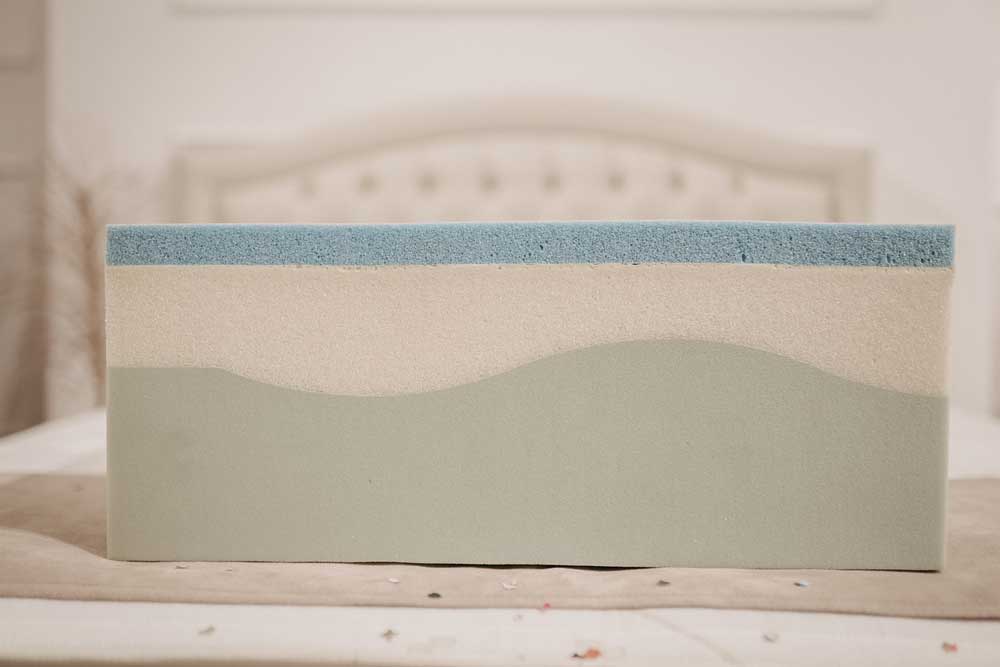
Most of the best-known mattress brands offer hybrid and foam mattresses. Hybrids are more expensive because they have an innerspring layer, but you do not necessarily need the more expensive option.
Foam mattresses are simple products comprising various foam layers sandwiched together to create a stable sleeping platform. The lack of springs reduces bounce and responsiveness, providing a highly cushioned sleep.
Hybrids build on foam construction with micro springs or pocket springs, which introduce responsiveness, making it easier to toss, turn, and move around. The springs also provide additional support and can be firmer than foams.
Ultimately, hybrid mattresses are more advanced than foam mattresses, but the foam is dependable and consistent and by no means the poorer option. This article weighs up both mattress technologies to help you choose.
Let’s jump in!
What is a foam mattress?
Foam mattresses have a 100% foam construction. They are made with either latex or memory foam – latex foam is a natural material with high responsiveness, while memory foam is a synthetic material with low responsiveness. In other words, memory foam holds its shape while latex foam bounces back.
The critical difference between a foam and a hybrid mattress is the lack of springs – foam mattresses have a ‘core support foam’ in place of springs, stabilising the softer foams and providing a stable sleep platform.
Many people prefer the lack of bounciness of foam mattresses, especially when they want pressure relief and a squishy sleep.
Foam advantages
- Cheaper than hybrid technology
- Squishier feel
- Best movement and motion isolation
Foam disadvantages
- Less nuanced support
- Not the best for zoned sleep
What is a hybrid mattress?
Hybrid mattresses have foam and innerspring construction, combining foam’s squishiness with springs’ responsiveness. The result is a balanced mattress that is squishy yet bouncy but also on the firmer side. If you like a firmer mattress with a little bounce, we recommend a hybrid mattress over a foam mattress.
Hybrid mattresses can use open coil springs or pocket springs, although open coil springs are becoming rarer due to reliability concerns. Pocket springs work individually, offering the best support.
If you want your mattress to offer pressure relief and body contouring with some bounce, a hybrid mattress is the best option for you.
Hybrid advantages
- Greater support
- Firmer feel
- Suitable for more sleep positions
Hybrid disadvantages
- Less movement isolation
- More expensive
Should I pay more for a hybrid?
Generally, hybrid mattresses offer a nicer sleep experience than pure foam mattresses because the spring layer improves responsiveness and support. Foam mattresses can feel like a one-trick pony with their squishiness.
However, foam mattresses are cheaper than hybrid mattresses – usually by several hundred pounds like for like. This isn’t because they are worse mattresses but because they are easier and cheaper to make.
A foam mattress provides excellent cushioning and moderately good support. Still, it is crucial to recognise the limitations of the foam construction – that the core support foam (which makes up the bulk of the mattress) does not provide nuanced support.
We recommend spending extra on a hybrid mattress if you want a higher support standard. However, you might find that most hybrids are medium-firm, like the Mlily Bamboo Ortho, which is the best firmness rating for back sleepers and front sleepers.
A medium mattress is a better option if you are a side sleeper. Most pure foam mattresses are medium, but you can also get medium hybrids like the Sleepeezee Jessica.
Summing up
Pure foam mattresses are more affordable than hybrids because they are simpler, comprising foam layers glued together with no springs. However, pure foam construction has limitations in terms of support and responsiveness.
Hybrid mattresses have no downsides other than being more expensive and the spring system introducing a little motion transfer. Pound for pound, a hybrid mattress is a better option if you can afford the extra outlay.
